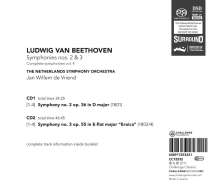Ludwig van Beethoven: Symphonien Vol.4 auf 2 Super Audio CDs
Symphonien Vol.4
Die SACD verwendet eine höhere digitale Auflösung als die Audio-CD und bietet außerdem die Möglichkeit, Mehrkanalton (Raumklang) zu speichern. Um die Musik in High-End-Qualität genießen zu können, wird ein spezieller SACD-Player benötigt. Dank Hybrid-Funktion sind die meisten in unserem Shop mit "SACD" gekennzeichneten Produkte auch auf herkömmlichen CD-Playern abspielbar. Dann allerdings unterscheidet sich der Sound nicht von einer normalen CD. Bei Abweichungen weisen wir gesondert darauf hin (Non-Hybrid).
(soweit verfügbar beim Lieferanten)
Symphonien Nr. 2 & 3
- Tonformat:
- stereo & multichannel (Hybrid)
- Künstler:
- Netherlands Symphony Orchestra, Jan Willem de Vriend
- Label:
- Challenge
- Aufnahmejahr ca.:
- 2010
- Artikelnummer:
- 1491586
- UPC/EAN:
- 0608917253221
- Erscheinungstermin:
- 24.11.2011
Willem de Vriends Beethoven-Sicht im Spiegel seiner historischen Wurzeln
Auch mit der vierten Folge aus seinem neuen Beethoven-Zyklus wagt Jan Willem de Vriend, zusammen mit dem Netherlands Symphony Orchestra, eine neue Sicht auf diese berühmten Werke. Mit enormer Leidenschaft und großem Engagement taucht er ein in Leben und Werk von Ludwig van Beethoven. Auch bei seiner Arbeit mit dem Combattimento Consort Amsterdam kam er sehr oft mit der Musik von Beethoven und dessen Vorgängern in Berührung. Dabei hat er das Bild jener Zeit gründlich kennengelernt, und mit diesen Kenntnissen kann er jetzt seine Geschichte in der Tat konstruieren.
Product Information
A refreshing new recording of the Beethoven symphonies (volume 4), through the eyes of conductor Jan Willem de Vriend and his orchestra. De Vriend's name as a symphonic conductor is emerging fast now in the music world, and this first volume of the Beethoven series is a fine musical signature, with which he and his musicians perpetuate themselves.
In the linernotes with this CD we can read: “I heard your ballet yesterday and it pleased me very much!", so said Haydn to Beethoven in 1801, to which Beethoven replied: "O dear Papa, you are very kind; but it is far from being a Creation!". Haydn was surprised and almost insulted by this remark, and he retorted: "That is true; it is not a Creation and I can scarcely believe that it will ever become one."
According to William Kinderman, this anecdote – about Beethoven’s ballet The Creation of Prometheus – is very plausible and also quite typical. It shows Beethoven’s predilection for plays on words. Haydn’s great oratorio The Creation (Die Schöpfung) had recently had its first performance, and it is telling that the two composers agreed that the ballet was "far from a Creation". According to Kinderman, the Prometheus ballet is a creation myth in its own right, but it is actually the music of the Eroica that personifies the Promethean stature and that can be seen as the “creation”.
The myth of the Titan Prometheus as it was used by the Italian dancer and choreographer Salvatore Viganò and Beethoven in the ballet was not entirely in accordance with the Greek original. In the version of Viganò and Beethoven, Prometheus shaped human civilisation: he was a philosopher and teacher, not a victim who spent many years chained to a rock. Prometheus sculpts two creatures from clay and gives them the fire he has stolen from the gods, thus animating them. It is the only way to impart knowledge and culture to his creations (i. e. mankind). Unfortunately, Prometheus pays for this with his life. But … of course this version has a happy ending, thanks to the intervention of the god Pan, who brings him to back life. Prometheus is then praised by his two archetypal creations for his heroic deed.
According to Lewis Lockwood, the Prometheus ballet, composed in the winter of 1800-1801, paved the way from the Second to the Third Symphony. It is widely known that the finale of the Eroica uses a theme from the ballet. Kinderman goes one step further, saying that Beethoven also used many other symbolic and dramatic elements from the ballet in this symphony, and not just in the finale.
But back to the Second Symphony. Beethoven composed it during a time of deep personal crisis. His health, and his hearing in particular, was fast declining; he felt isolated and depressed. The situation was so serious that there were times when he no longer wished to live. At least we can deduce this from the famous Heiligenstadt Testament, which he wrote to his brothers (and to humanity) in 1802. He wrote it, putting more or less all his thoughts on paper, and then filed it away. It would not resurface until after his death. The music of the Second Symphony exudes Beethoven’s desire to rise above his personal difficulties (although naturally traces of his misery as well can always be found in his music). Lockwood: “His ability to nurture his creative psyche and protect it from the physical and psychological anguish of his growing deafness is one of the more remarkable features of his life.”
Disk 1 von 2 (SACD)
-
1 Symphony No. 2 Op. 36 In D Major
-
2 Symphony No. 2 Op. 36 In D Major
-
3 Symphony No. 2 Op. 36 In D Major
-
4 Symphony No. 2 Op. 36 In D Major
Disk 2 von 2 (SACD)
-
1 Symphony No. 3 Op. 55 In E-Flat Major A"eroicaa"
-
2 Symphony No. 3 Op. 55 In E-Flat Major A"eroicaa"
-
3 Symphony No. 3 Op. 55 In E-Flat Major A"eroicaa"
-
4 Symphony No. 3 Op. 55 In E-Flat Major A"eroicaa"
Mehr von Ludwig van Beet...
-
Ludwig van BeethovenDie Geschöpfe des Prometheus op.43CDVorheriger Preis EUR 7,99, reduziert um 0%Aktueller Preis: EUR 2,99
-
Ludwig van BeethovenMödlinger Tänze WoO 17 Nr.1-11CDAktueller Preis: EUR 7,99
-
Carl Heinrich ReineckeSämtliche Klaviertrios2 CDsAktueller Preis: EUR 14,99
-
Schuppanzigh Quartett - Beethoven / Ries / RodeCDAktueller Preis: EUR 14,99








